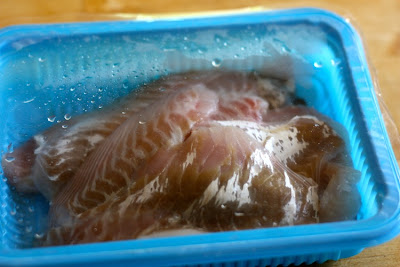 |
| Having a total flashback. . . Have I already posted this recipe? I sincerely hope not. I know I've never posted this exact photo, given that this is the actual egg I ate for lunch an hour ago. |
I love vinegar and always have. Pickled anything, tangy slaws, sharp salad
dressings, salt and vinegar potato chips, white-vinegar-doused collards,
vinegary hot sauces, you name it. And I love vinegar reduced with a bit of
butter—which is as versatile a little sauce as you could hope to make. You can
use balsamic vinegar or wine vinegar, and it’s great on asparagus, grilled
chicken, frittata, even plain brown rice. But this recipe here works best with mellow,
smoky sherry vinegar, and it makes one of those absolutely simple, absolutely
perfect dishes that is so delicious you could stand up with your eggy fork to
sing a song of richness and clarity. The golden yolks run into the buttery vinegar
to make something like a dark, ad hoc hollandaise sauce for the toast and white, and
it is just as good as you know it’s going to be when the vinegar hits the pan
in a cloud of jaw-cramping aroma. Plus, as an added selling point, it takes
about 3 minutes to make. I would estimate that Michael and I, alone and
together, eat this for lunch on 3 out of 5 weekdays, and have for years. And I
should mention that this is how Michael started liking fried eggs—which he had
never liked before. Ben loves it too, and Birdy doesn’t, but only because she
doesn’t like fried eggs—not because of the vinegar, which tempts her. If we’re
eating this for dinner, she has her eggs poached instead.
The original recipe is Deborah Madison’s, from Local Flavors, which is a cookbook that
I find deeply inspiring around this time of year, when food starts coming in
fresh at the farmer’s market, and also a bit later, when our CSA farm share comes
on hot and heavy. I read the recipe’s title and knew it would be just my
kind of thing. She uses a little diced shallot, which she adds to the pan when
she adds the second round of butter. If I have shallot, and I usually do not, I
add it too, and it’s wonderful—but really, you don’t need it. You do need the
best eggs you can get (still, we’re talking about a really cheap meal here)
and, ideally, sherry vinegar—although wine vinegar will work in a pinch. Try
this, even if it sounds bizarre. And report back.
p.s. Ben is home sick and just fell asleep on the couch by me while I was typing. I cannot remember the last time I've seen him asleep during the day. Highish fever, baby face, no other symptoms. Is this going around?
 |
| Warning: some scenes may contain animals on the table where people are eating. |
Fried Eggs with
Sizzling Vinegar
Serves 2 (can be halved or doubled most straightforwardly)
Adapted from Local Flavors by Deborah Madison. If you can’t get great eggs… try harder.
Kidding! Make it anyways, because it will still be better than plain not-great fried
eggs, which, believe me, I still end up eating often enough.
2 pieces of bread
2 tablespoons butter, divided use
2 very fresh eggs
1-2 tablespoons sherry vinegar
Kosher salt and pepper
Put the bread in the toaster and heat a nonstick pan over
medium-low heat. Add half the butter, then break in the eggs and fry them
however you like your eggs. We like them over easy. When they’re done, slide
each onto a piece of toast.
Add the rest of the butter to the pan, along with the
vinegar and a generous pinch of salt and grinding of black pepper (now is when
you could add a small chopped shallot, which I so seldom use I don’t even
mention it in the ingredients, but it’s good). Swirl the pan until the sauce is
foamy and reduced some (it should like shiny but not like heavy syrup—not that
it really matters that much), then turn off the heat and divide the sauce over
the eggs over the toast. Eat hot.
 |
| Yum. |










































